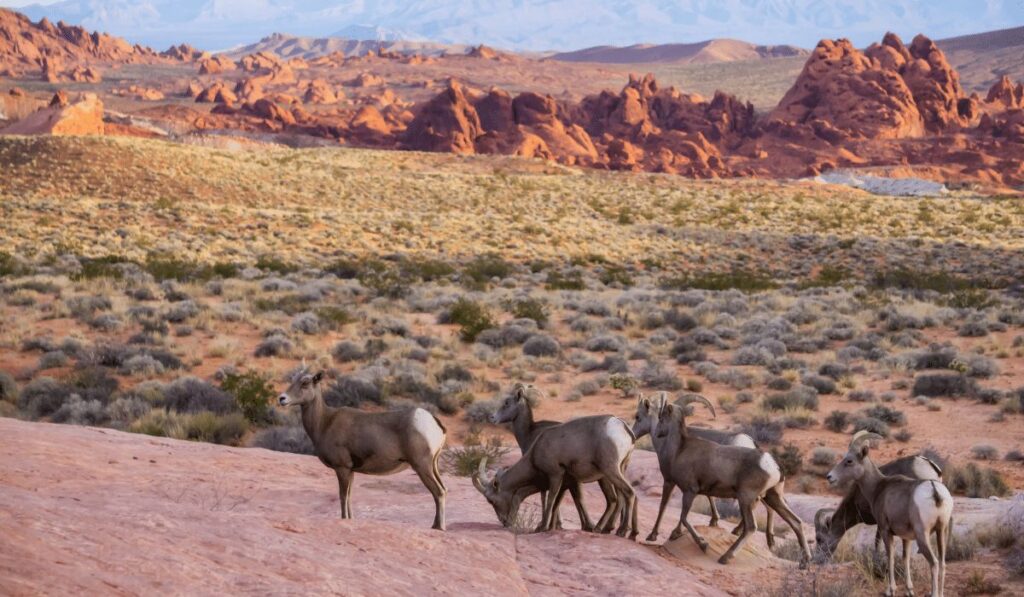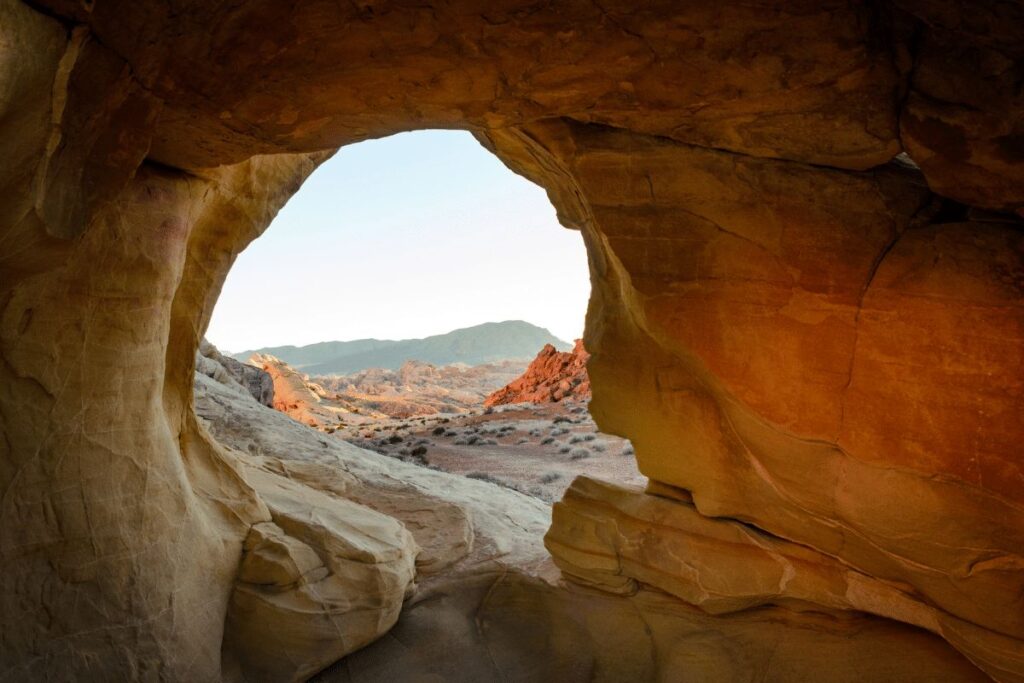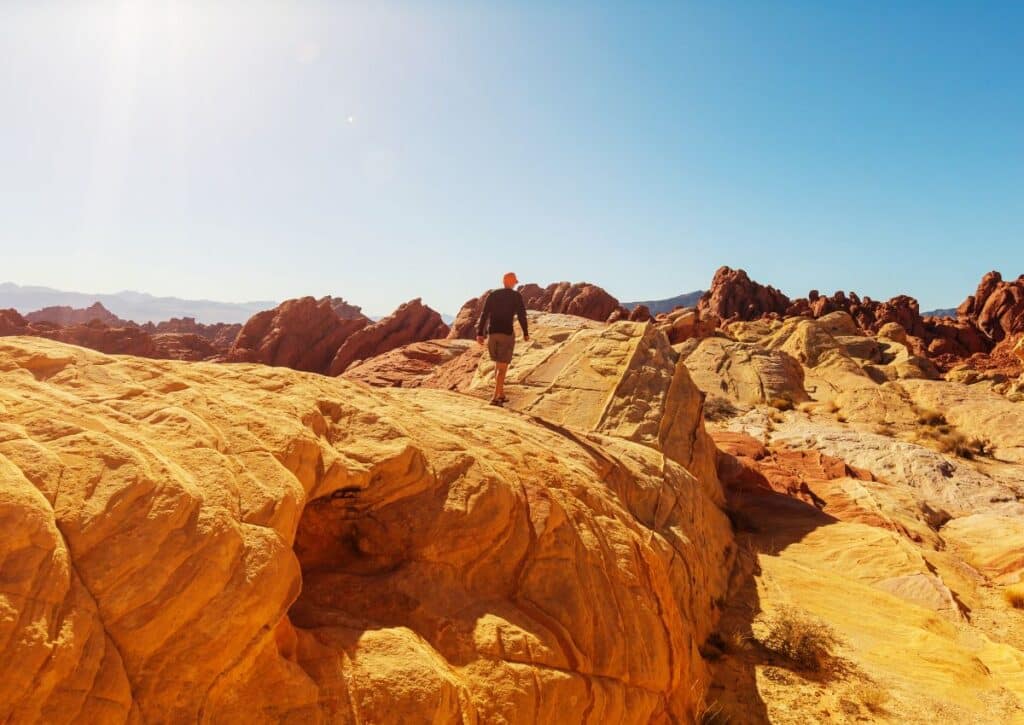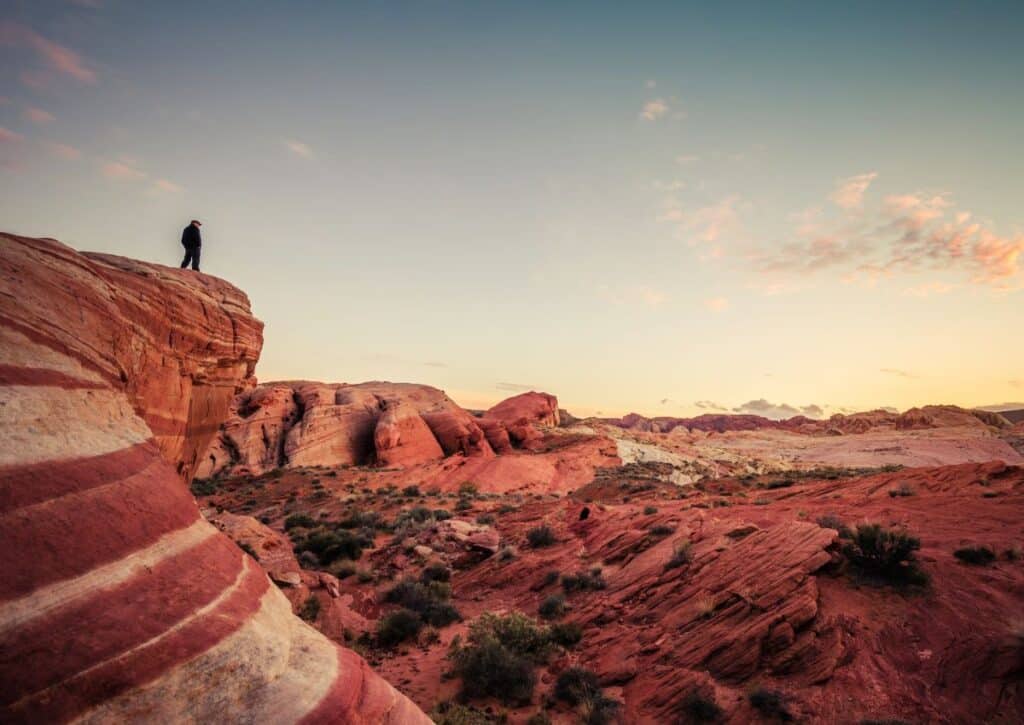Explore 15 Valley of Fire animals spotted on hikes! From coyotes to bighorn sheep, discover trails, photos, and tips for wildlife viewing in this desert haven.
Over the years, we have realized Valley of Fire State Park offers more than stunning vistas; it’s a living showcase of desert wildlife.
It’s the resilience and the desert’s ability to spring surprises that makes us want to come back again and again.
Valley of Fire State Park is home to a captivating array of species. Encounter coyotes, observe red-tailed hawks, spot desert kit foxes, and admire the iconic bighorn sheep.
Dive into our exploration for a closer look at these remarkable inhabitants.
Overview of Wildlife in Valley of Fire State Park
The Valley of Fire State Park, located in Nevada, is more than just its iconic red sandstone landscapes. As experts who’ve spent significant time in the park, we can attest that it’s a hotspot for diverse desert wildlife.
Here, amidst the rugged terrain, animals have adapted brilliantly to the harsh desert conditions.
From the bighorn sheep, skilled in navigating rocky terrains, to the elusive desert kit fox, the park teems with life.
The skies often feature red-tailed hawks and busy Costa’s hummingbirds, while on the ground, you might encounter the Mojave Fringe-toed Lizard or even the Speckled Rattlesnake. And let’s not forget the slow-paced desert tortoise, emblematic of desert endurance.
After hiking here for ober 2 decades, we encourage visitors to approach with respect and patience. This desert ecosystem is intricate, with each species playing a vital role in maintaining its balance.
Simply put, Valley of Fire State Park is a testament to nature’s adaptability, showcasing a range of wildlife that has expertly carved a niche in this demanding environment.
Coyote
The coyote, a prominent figure of the American West, stands out with its grayish-brown to yellowish-gray coat. Throat and belly are contrasted with a lighter white, adding to its distinct appearance.
Their pointed ears and bushy tail, which often carries a black tip, are key features that make them easily recognizable.
In the Valley of Fire, these adaptable creatures predominantly roam the open plains and deserts. However, don’t be surprised if you spot them on the outskirts of developed areas within the park, showcasing their versatile nature.
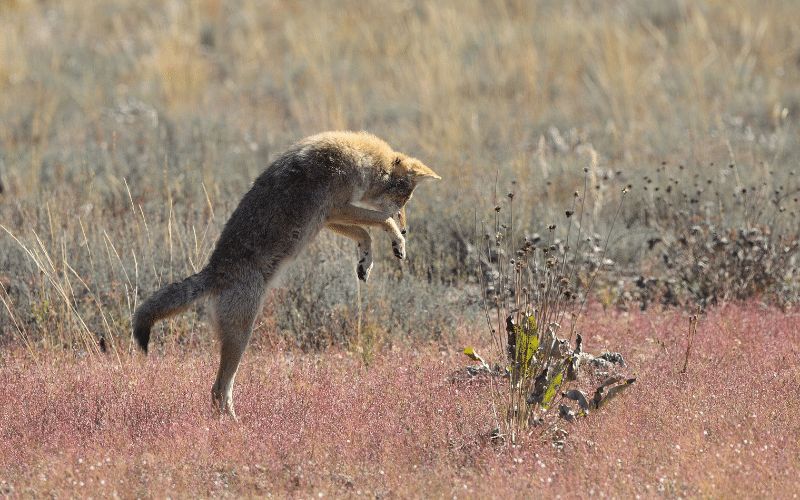
Based on our extensive observations, Atlatl Rock and Mouse’s Tank Trail seem to be their favorite spots, especially during the tranquil hours of early morning or the golden hues of late evening.
Now, for those curious about the sounds echoing through the wilderness, the coyote has a fascinating range of vocalizations.
From yips and barks to the iconic howls, these sounds serve various purposes — be it communicating with pack members or warding off intruders. And, if you’ve ever wondered about their diet, coyotes are quite the opportunistic eaters.
They’re omnivores by nature, feasting on small mammals, birds, and even fruits and vegetables when the opportunity arises.
Their adaptability doesn’t just end with their diet; from sprawling deserts to bustling urban areas, the coyote truly is a testament to nature’s resilience.
House Finch
The House Finch, with its vibrant flashes of color, is a true visual delight.
Males often boast a brilliant red on their heads and throats, which can sometimes extend to their chests, setting them apart from the females who usually don a more subdued brown-streaked appearance.
While they might be named “House” Finches, don’t let the moniker fool you; these birds love the expansive wilderness as much as any cozy neighborhood.
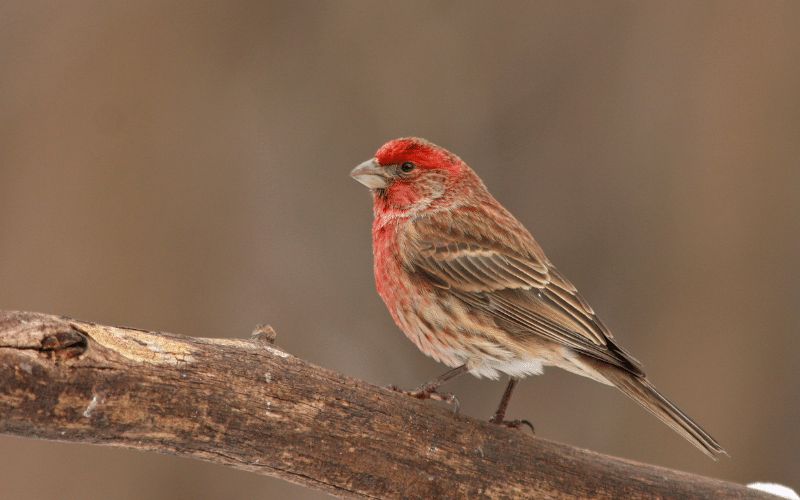
In the Valley of Fire, they’re most frequently spotted in areas with dense vegetation or near water sources, making trails like Rainbow Vista and the Petrified Logs Loop prime locations for a sighting.
Early morning birdwatchers are likely to be rewarded with their melodious songs, as these finches are known to be quite the songsters.
A captivating tidbit about these little songbirds is their adaptable nature. Originally, they were native to the western U.S., but now they’ve spread almost throughout the entire continent, showcasing their ability to thrive in diverse environments.
When it comes to their diet, seeds are the mainstay, but they won’t shy away from the occasional insect, especially during breeding season.
Witnessing the House Finch in its natural environment, chirping away and flitting from branch to branch, is sure to be one of the many highlights of your journey through the Valley of Fire.
Red Tailed Hawk
Majestically soaring above the Valley of Fire, the Red-Tailed Hawk is a sight that commands attention.
This raptor, known for its impressive wingspan and characteristic reddish-brown tail, showcases a blend of brown and white on its body, with the mature ones displaying their namesake red tail to its full glory.
Within the vast landscapes of the Valley of Fire, these hawks prefer open areas, from desert plains to scrublands, where they can soar freely and spot potential prey from great heights.
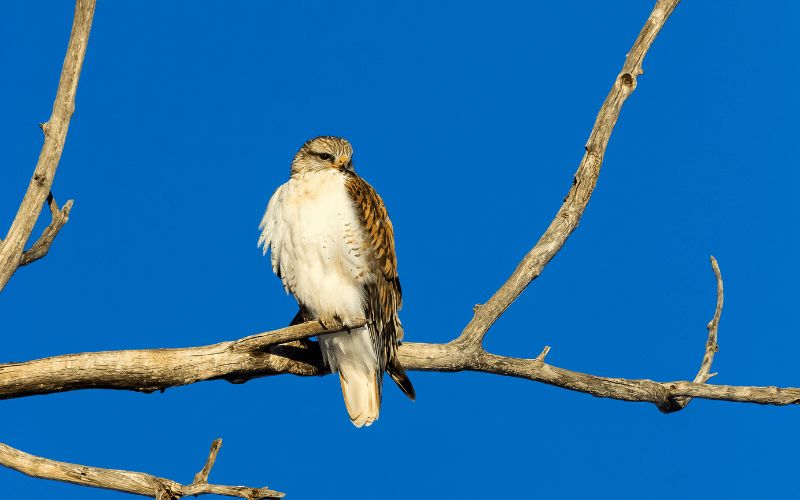
For those eager to catch a glimpse of this avian wonder, trails like White Domes and Fire Wave Trail serve as excellent vantage points. Especially during mid-mornings, when thermal currents rise, these birds use them to glide effortlessly, offering observers a breathtaking aerial display.
What makes the Red-Tailed Hawk even more fascinating is its hunting prowess. Their keen eyesight, almost eight times as sharp as a human’s, enables them to spot mice, rabbits, and other small animals from a considerable distance.
Once locked onto their target, they dive with precision, capturing their prey with their powerful talons.
It’s not just their physical abilities that intrigue; their calls are equally captivating. The Red-Tailed Hawk’s piercing scream is often used in movies to depict any raptor, testament to its iconic nature.
So, as you traverse the Valley of Fire, let the sight and sound of the Red-Tailed Hawk be a reminder of the wild and untamed beauty of this remarkable land.
Black-tailed Jackrabbit
As you traverse the vast landscapes of the Valley of Fire, the swift dashes of the Black-tailed Jackrabbit might catch your eye.
Distinguished by their impressively large ears and long legs, these hares present a mix of gray and brown on their bodies, leading down to the distinct black tail from which they derive their name.
Venturing across the arid terrains of the Valley of Fire, these jackrabbits favor open desert areas and grasslands. They’re especially prevalent near trails like Atlatl Rock and the Pinnacle Loop.
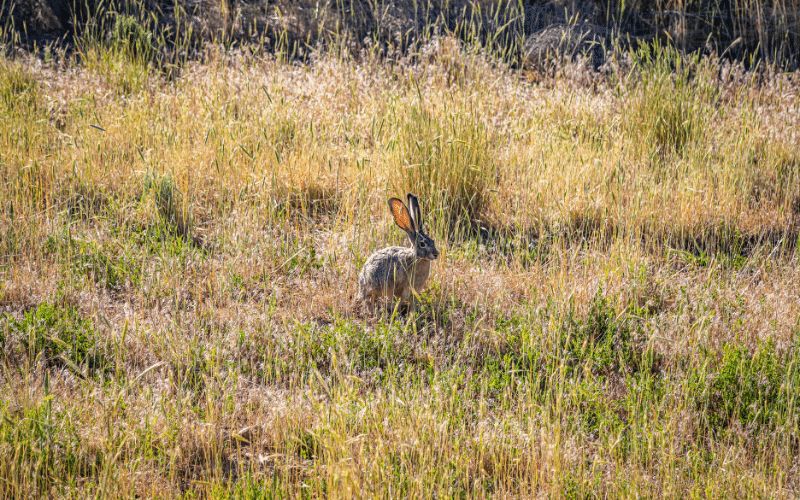
As primarily crepuscular creatures, the best times to spot them are during the serene moments of dawn or the soft glow of dusk. Their chosen hours are strategic, allowing them to forage while evading the desert’s midday heat.
The oversized ears of the Black-tailed Jackrabbit aren’t just for show. They serve as a crucial thermoregulatory tool, dissipating heat and helping these animals stay cool in the desert environment.
Their diet is quite varied, feasting on a range of plants, shrubs, and even tree bark during tougher times.
A curious fact about these jackrabbits is their incredible speed and agility. When threatened, they can reach speeds of up to 35 miles per hour and make sudden, unpredictable jumps, ensuring their survival against potential predators.
As you journey through the Valley of Fire, the elusive yet ever-present Black-tailed Jackrabbit serves as a testament to the adaptability and resilience of desert life.
Desert Bighorn Sheep
Among the rugged terrains and fiery landscapes of the Valley of Fire, the Desert Bighorn Sheep stands as an emblem of strength and endurance.
These magnificent creatures, characterized by their spiral horns and robust build, display a coat of short, sandy fur, enabling them to blend seamlessly with the desert surroundings.
A unique feature of the Valley of Fire is its rocky outcrops and steep cliffs, terrains that the Desert Bighorn Sheep has masterfully adapted to.
These areas, particularly around the Silica Dome and Elephant Rock Trail, offer the best opportunities for sightings.
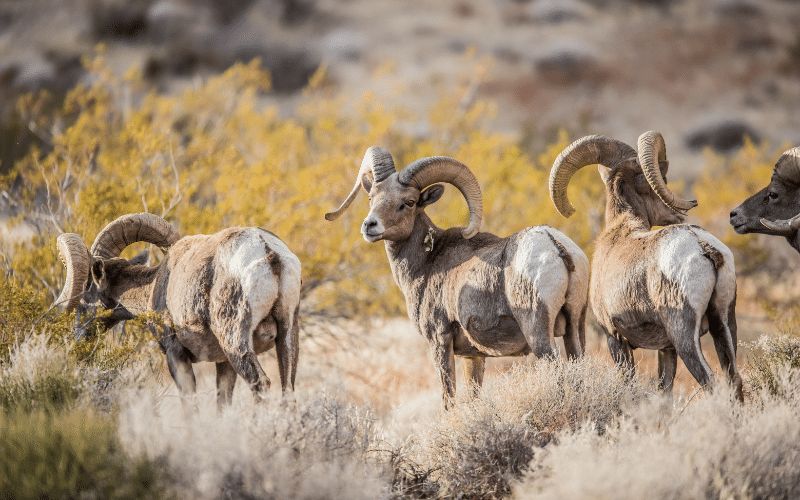
Being sure-footed and agile, they effortlessly navigate the challenging topography, often standing proudly atop ridges, surveying their domain.
Beyond their remarkable physical attributes, the Bighorn Sheep have a fascinating social structure. Males, or rams, often engage in head-butting contests, a display of dominance and prowess, with the sound of their clashing horns echoing for miles.
On the other hand, the females, or ewes, work collaboratively, keeping a watchful eye on their young and guiding them through the intricacies of desert life.
Their diet, predominantly consisting of desert plants and grasses, sees a shift during the dry months. During these times, they venture to higher elevations in search of nourishment and water sources, showcasing their resourcefulness.
When you encounter a Desert Bighorn Sheep in the Valley of Fire, you’re not just seeing an animal; you’re witnessing the spirit of the desert — resilient, majestic, and indomitable.
Greater Roadrunner
Amidst the vast stretches of the Valley of Fire’s desert landscape, the quick and quirky movements of the Greater Roadrunner often capture the attention of travelers.
A long-tailed bird with a distinctive crest, this charismatic creature dons a mix of brown, black, and white plumage, allowing it to blend effortlessly with the desert surroundings.
While their animated portrayal in popular culture might suggest otherwise, these birds are quite at home on the ground. In fact, they’re more often seen running than flying, clocking speeds of up to 20 miles per hour.
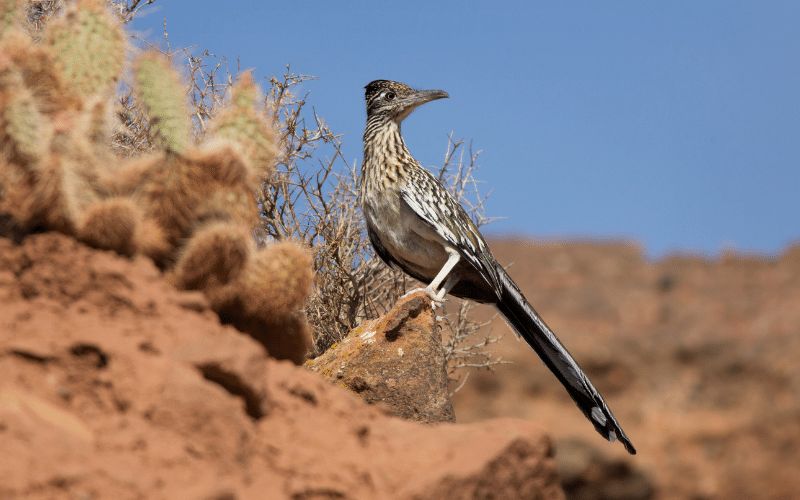
Key spots for sightings within the park include the Mouse’s Tank Trail and Balancing Rock Trail. And if you’re there during the morning hours, you might just witness them sunbathing, spreading their wings and tail to soak up the warm rays.
But there’s more to the roadrunner than its iconic speed. This bird is a carnivorous dynamo. Armed with agility and keen eyesight, it preys on everything from insects to small reptiles.
One of its notable hunting tactics involves tailing a rattlesnake, quickly darting in to peck its head, and then consuming it.
Additionally, the cooing sounds of the Greater Roadrunner, reminiscent of a dove’s call but with a more melodious twist, add a unique auditory element to the Valley of Fire’s ambiance.
As you embark on your journey through the park, let the sights and sounds of the Greater Roadrunner serve as a reminder of nature’s whimsy and wonder embedded in this desert sanctuary.
Antelope Ground Squirrel
In the vast, sun-drenched expanses of the Valley of Fire, the petite and energetic Antelope Ground Squirrel plays a vital role in the ecosystem’s tapestry.
With a slender body adorned in a mix of beige and brown, and distinct white stripes running laterally on their sides, these ground squirrels present a charming sight against the reddish backdrop of the desert.
These creatures can often be seen scurrying across the desert floor, particularly around trails such as the Petrified Logs Loop and Arch Rock Campground.
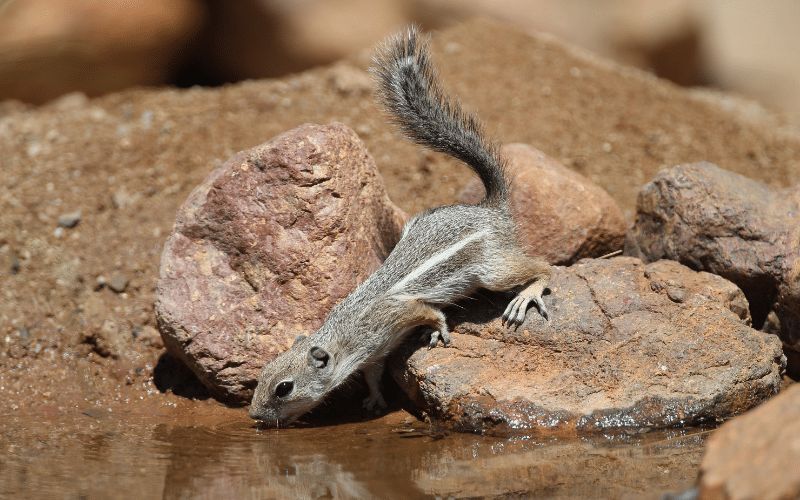
While they are most active during the early morning and late afternoon, their burrows provide them a cool refuge during the intense midday heat.
A noteworthy adaptation of the Antelope Ground Squirrel is its ability to regulate body temperature. Even in the scorching desert climate, they can lower their body heat, enabling them to remain active during warmer periods when most animals seek shelter.
Their diet primarily consists of seeds, fruits, and occasionally insects, which they often store in their cheek pouches for later consumption.
Beyond just being adorable residents of the Valley of Fire, these squirrels play a crucial role in the ecosystem.
Their foraging habits help disperse seeds, promoting plant growth, while their burrows offer shelter to various other desert inhabitants.
So, as you traverse the Valley of Fire’s trails, take a moment to appreciate the tiny, bustling Antelope Ground Squirrels. They not only symbolize the desert’s vitality but also its intricate, interconnected web of life.
Desert Kit Fox
Stealthily navigating the sprawling terrains of the Valley of Fire, the Desert Kit Fox emerges as a symbol of elegance and adaptability.
Possessing a slender frame, large ears, and a bushy tail, these foxes exhibit a pale gray or tan coat, perfectly attuned to the desert’s hues.
While they are primarily nocturnal, venturing out during the cooler nights, early risers or late evening visitors might catch a fleeting glimpse of them near the Fire Wave Trail or Pinnacle Loop.
Their large ears, apart from being an endearing feature, play a dual role. They’re finely tuned instruments for detecting prey and also serve as a cooling mechanism, releasing excess body heat.
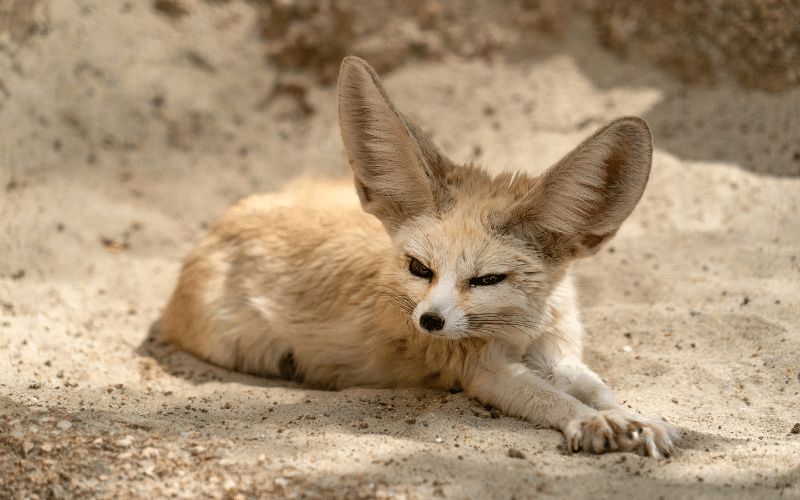
The Desert Kit Fox’s diet showcases its adaptability. They consume a variety of desert inhabitants, from insects and small rodents to lizards and birds.
They are also known to eat fruits and plants when animal prey is scarce, showcasing their versatile palate.
One of the more captivating aspects of the Desert Kit Fox is its denning behavior. Not only do they use burrows for shelter and raising their young, but they also have multiple dens scattered across their territory, allowing them quick escapes from predators.
As you wander through the Valley of Fire, the elusive Desert Kit Fox stands as a testament to the beauty of evolution and the nuances of desert survival.
Its presence reminds us of the delicate balances and intricate relationships that define this breathtaking environment.
Gambel’s Quail
Meandering through the Valley of Fire, the spirited calls and jaunty movements of the Gambel’s Quail often resonate with visitors.
Recognizable by their plump bodies, short tails, and the iconic black plume or “topknot” dangling from their heads, these birds present a delightful mix of blue-gray plumage with chestnut accents, especially on the males.
Frequenting the brushy and shrubby areas of the desert, these quails are particularly active during the cooler hours of dawn and dusk. The Rainbow Vista and Seven Sisters trails offer prime spots for observing their daily routines.
They move in coveys, or small groups, often scurrying on the ground with sporadic bursts of flight when startled.
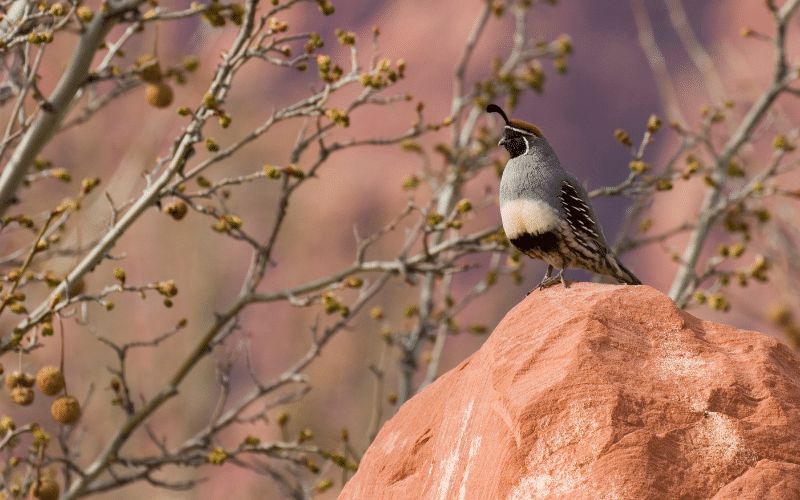
What stands out about the Gambel’s Quail, apart from their distinct appearance, is their rich vocal repertoire.
Their calls, a series of sharp, rhythmic notes, often serve as a melodious desert soundtrack, signaling their presence or communicating with their group.
Their diet is versatile, feeding primarily on seeds, but they’re also known to eat berries, small insects, and occasionally green vegetation.
As ground nesters, they craft their nests in concealed spots, shielded by vegetation, ensuring the safety of their eggs and chicks from potential predators.
The Gambel’s Quail not only adds a splash of color and sound to the Valley of Fire but also embodies the vitality and resilience of desert avian life.
As you traverse the park, their presence offers a charming interlude, reminding us of nature’s diverse tapestry in this arid haven.
Costa’s Hummingbird
In the vast landscapes of the Valley of Fire, the iridescent flash and agile dance of the Costa’s Hummingbird add a touch of magic to the desert skies.
This diminutive bird, often measuring just three to three and a half inches in length, boasts a striking plumage.
Males are particularly dazzling with their deep purple, almost black, crown and gorget (throat), which can flare out in a spectacular display during courtship.
These hummingbirds can often be seen darting between desert flowers and shrubs, extracting nectar with their specialized long bills.
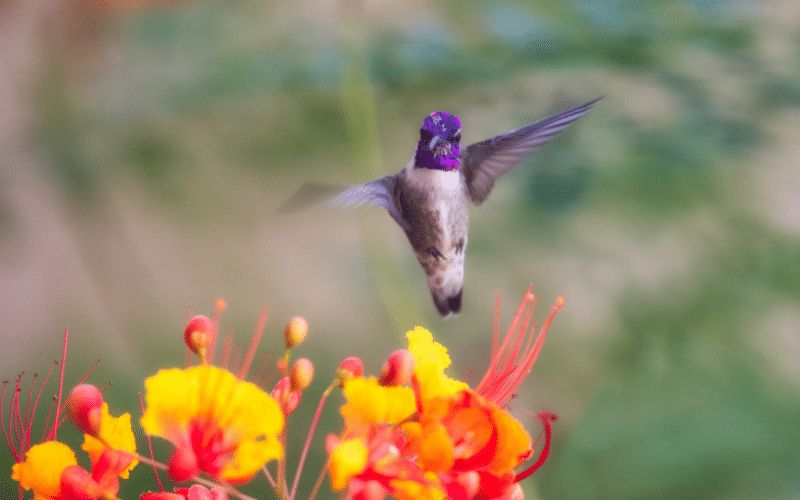
Areas around the White Domes Trail and Atlatl Rock are great spots for sightings, especially during the blooming season when flowers are abundant.
But it’s not just the nectar that draws them. Costa’s Hummingbirds are adept insect catchers, plucking them from the air or off vegetation, providing essential proteins to their diet.
Their rapid wing beats – at an astonishing rate of up to 80 times per second – grant them the ability to hover effortlessly and change directions with precision.
Their nesting habits are equally fascinating. These birds craft tiny, cup-shaped nests using plant fibers, attaching them to branches or shrubs.
These nests, often no larger than a walnut, cradle their eggs, which are about the size of a pea.
The presence of the Costa’s Hummingbird in the Valley of Fire is a testament to nature’s wonders in the desert.
They not only symbolize grace and beauty but also demonstrate the intricate balance of life in such a challenging environment.
Whenever you catch a glimpse or hear the soft hum of their wings, it’s a moment to pause and appreciate the delicate marvels of the natural world.
Speckled Rattlesnake
Among the silent rocks and undulating sands of the Valley of Fire lurks a creature as mesmerizing as it is formidable: the Speckled Rattlesnake.
Sporting a pattern of intricate speckles over a base color that can range from whitish-gray to pink or even deep red, this snake is a master of camouflage within the desert terrain.
Its preferred habitats are rocky areas and canyon terrains, where its cryptic coloration allows it to lie in wait for unsuspecting prey.
Trails like the Fire Wave Trail or Petrified Logs Loop occasionally offer glimpses of this elusive reptile, especially during the cooler parts of the day.
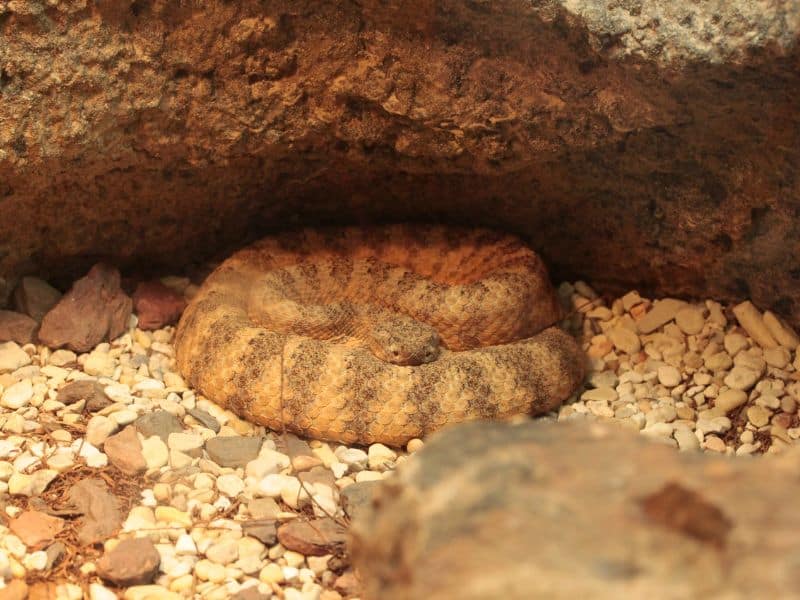
The Speckled Rattlesnake, like other rattlers, possesses a set of heat-sensitive pits between its eyes and nostrils, granting it a unique ability to detect the slightest warmth of nearby prey.
Its diet primarily consists of small mammals, lizards, and occasionally birds.
But what truly sets this snake apart is its iconic rattle. Comprising of interlocked segments, the rattle is vibrated to produce a warning sound when the snake feels threatened.
Each time the snake sheds its skin, another segment is added, though it’s a misconception that the number of segments directly indicates the snake’s age, as they can break off or wear out.
If you’re fortunate enough to encounter a Speckled Rattlesnake during your adventures in the Valley of Fire, it’s a reminder of nature’s inherent balance between beauty and danger.
Always observe from a distance and respect its space, recognizing its integral role in the desert ecosystem.
Chuckwalla
The vast terrains of the Valley of Fire hide many wonders, one of which is the robust and intriguing Chuckwalla. Belonging to the iguana family, the Chuckwalla is a large lizard, often reaching lengths of up to 16 inches, excluding its tail.
Their rough, granular skin dons a mottled pattern of browns, grays, and blacks, enabling them to blend seamlessly with the rocky environments they call home.
Favored spots for these creatures are the rocky outcrops and crevices, where they can bask under the sun and seek refuge from predators.
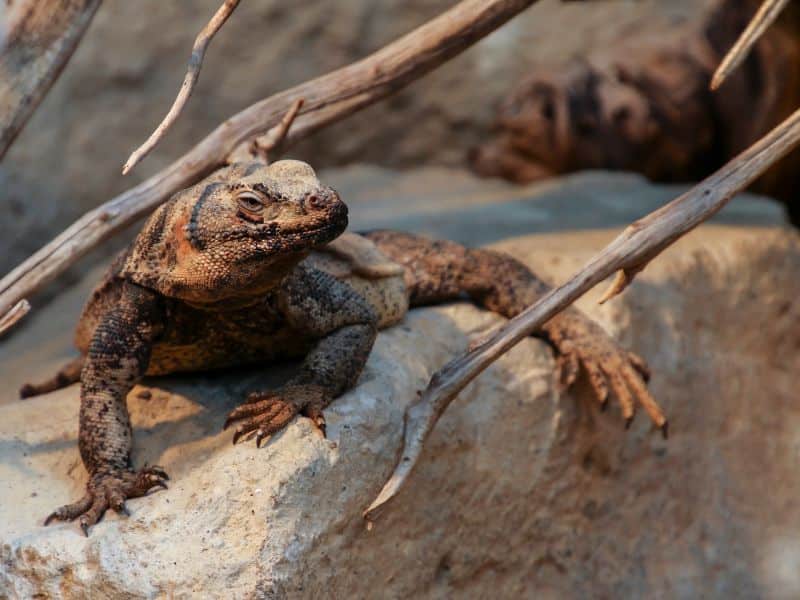
Trails like the Rainbow Vista and Silica Dome are promising locations for those keen on observing Chuckwallas in their natural habitat. The heat of the sun aids in their digestion, making them diurnal reptiles that are most active during daylight hours.
A herbivore by nature, Chuckwallas feast on a diet rich in leaves, flowers, fruits, and occasionally, insects. Their vegetarian inclination is a rarity among lizards, marking them as unique inhabitants of the desert.
When threatened, Chuckwallas employ a fascinating defense mechanism. They scuttle into rock crevices and inflate their bodies with air, making it difficult for predators to extract them from their safe haven.
As you traverse the terrains of the Valley of Fire, the Chuckwalla stands as a magnificent representation of adaptability and survival.
Their presence underscores the rich biodiversity of the desert and serves as a testament to life’s ability to thrive in even the harshest of conditions.
Desert Tortoise
Amid the sun-baked expanses and crimson cliffs of the Valley of Fire, the stoic journey of the Desert Tortoise unfolds, a testament to endurance and time.
This venerable creature, with its high-domed shell and stout, stumpy legs, is one of the desert’s most iconic inhabitants.
With a life span that can extend beyond 80 years, the Desert Tortoise is a living relic of the Mojave and Sonoran deserts. The shells, with their intricate patterns of growth rings, tell a tale of decades spent navigating the arid lands.
While the Elephant Rock Trail and Balancing Rock Trail are among the spots where one might chance upon this creature, sightings are becoming increasingly rare due to their declining population.
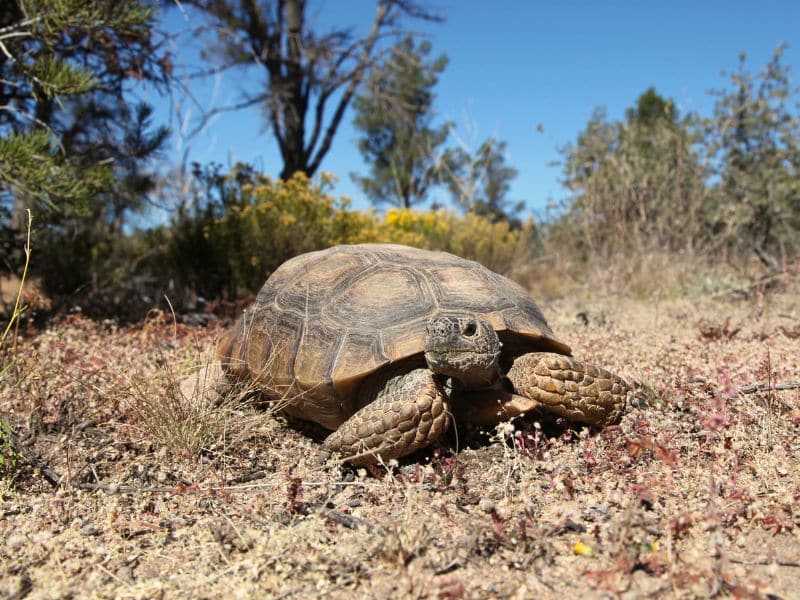
Primarily herbivorous, Desert Tortoises feed on a variety of desert plants, including cacti, herbs, and wildflowers.
Their sturdy beaks allow them to munch on tough vegetation, and during the rainy season, they consume vast amounts of water, storing it in their bladders to endure the prolonged dry spells that follow.
One of the most intriguing aspects of the Desert Tortoise is its ability to estivate, a form of summer dormancy. To escape the harshest temperatures, they burrow into the ground, often remaining inactive for extended periods.
Their presence in the Valley of Fire is not just a marvel but also a gentle reminder of the fragile balance of life in the desert.
Conservation efforts are in place to protect these ancient wanderers, ensuring that future generations can also be captivated by their slow and steady journey through time.
Tarantula
When evening shadows stretch across the Valley of Fire, a slow, deliberate movement might catch your eye. It’s the Tarantula, one of the desert’s most iconic and misunderstood residents.
This large, hairy spider, often spanning more than 4 inches in leg length, is a sight that evokes fascination and, for some, a tinge of apprehension.
While their size and appearance might seem intimidating, Tarantulas are generally docile towards humans.
They wander the desert floor, particularly around the Pinnacle Loop and Rainbow Vista, in search of prey, primarily insects, smaller spiders, and even small lizards.
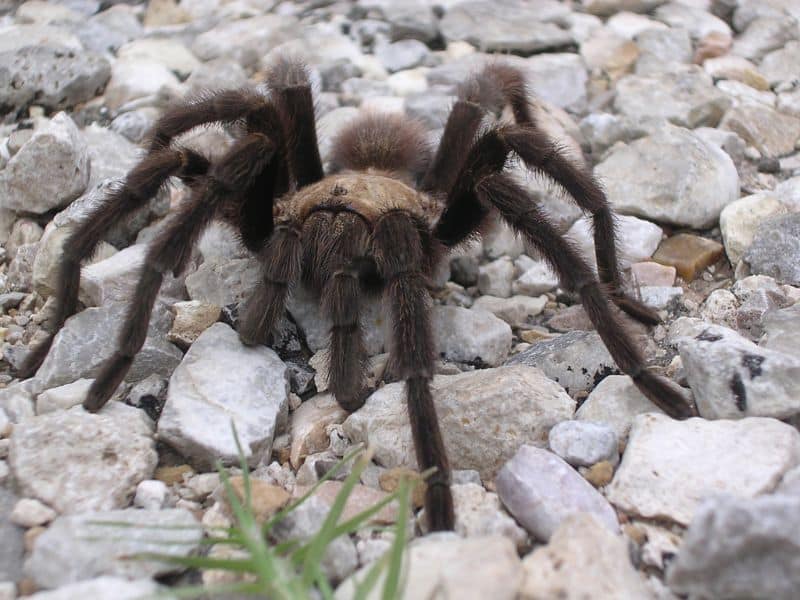
Their dense hairs, apart from offering sensory advantages, also serve as a defense mechanism. When threatened, they can release these hairs, which can be irritating to potential predators.
A remarkable aspect of the Tarantula’s life is its longevity. Female tarantulas can live up to 25 years, undergoing periodic molts which allow them to grow and repair their exoskeletons.
Witnessing a Tarantula in the Valley of Fire is to observe nature’s raw beauty, a creature perfectly adapted to its surroundings, deserving of respect and admiration.
Mojave Fringe-toed Lizard
Among the shifting dunes and rocky outcrops of the Valley of Fire, the Mojave Fringe-toed Lizard skims across the sand with astonishing speed.
With a slender body, reaching lengths of about 3 to 4 inches, this lizard’s most distinguishing feature is the fringe of elongated scales along its toes.
This adaptation enables it to move effortlessly on the sand, almost as if it’s surfing across the desert.
Frequent spots for sightings of this agile reptile are the sandy patches around the Atlatl Rock and Fire Wave Trail. Their coloration, a blend of sandy browns and whites, offers them perfect camouflage against the desert backdrop.
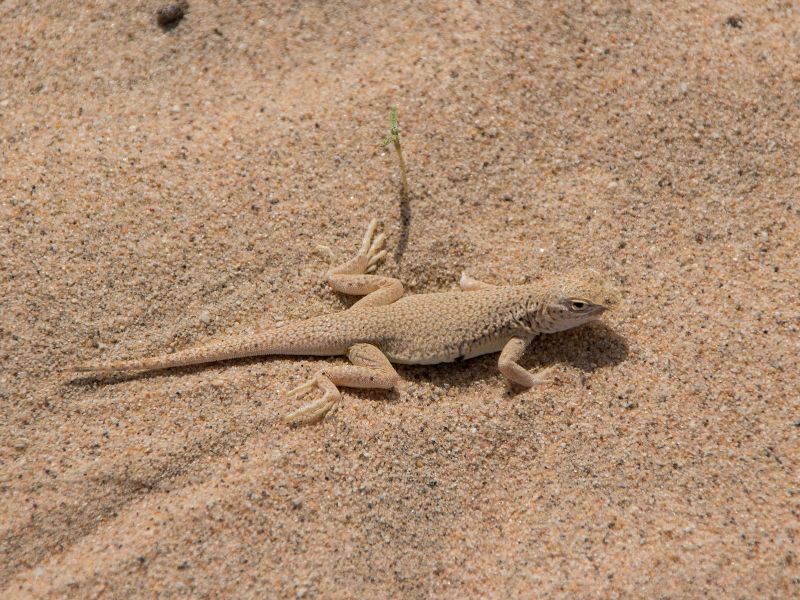
Omnivorous in nature, the Mojave Fringe-toed Lizard feeds on a variety of insects, seeds, and plants. Their keen eyesight and swift movements make them adept hunters in their sandy domain.
Their unique adaptation to the desert’s challenges, especially their specialized toes, is a striking example of evolutionary ingenuity.
Whenever you spot a Mojave Fringe-toed Lizard darting across the sand, it’s a moment that encapsulates the Valley of Fire’s spirit of adaptability and resilience.
Tips and Safety for Wildlife Viewing in Valley of Fire
Witnessing the diverse wildlife in the Valley of Fire State Park is a thrilling experience. To enhance your encounters and ensure both your safety and the well-being of the animals, consider the following guidelines:
- Optimal Viewing Times: Early mornings and late afternoons are typically the best times for wildlife viewing in the park. The cooler temperatures during these hours encourage many animals to be more active, offering a higher chance of sightings.
- The Art of Silent Observation: Patience and silence are essential when observing wildlife. Avoid making sudden movements or loud noises, as these can disturb the animals and deter them from their natural behaviors. A quiet observer will often be rewarded with more genuine and intimate wildlife encounters.
- Gear Up with Binoculars: A good pair of binoculars is a must-have for any wildlife enthusiast. They allow for close-up views without intruding upon the animals’ space. With binoculars, you can appreciate the detailed markings of a bird or the intricate patterns on a reptile, all from a respectful distance.
- Respect Their Space: Remember, you’re a guest in the home of these creatures. Always maintain a safe and respectful distance. Approaching too closely can stress animals and may even provoke a defensive reaction. If an animal appears agitated or changes its behavior due to your presence, it’s best to back away slowly.
- Safety First: Encounters with wildlife, while exciting, should be approached with caution. If you stumble upon a wild animal, especially a potentially dangerous one, it’s crucial to remain calm. Avoid direct eye contact, move slowly, and speak in a soft, reassuring tone.
- Avoid Feeding: It might be tempting to feed the cute squirrel or bird, but this act can have detrimental consequences. Feeding wildlife can lead to dependency on human-provided food, alter their natural behaviors, and even cause health issues. Moreover, it can increase the risk of aggressive animal behavior.
- Be Snake-Savvy: The desert is home to various snake species, some of which, like the Speckled Rattlesnake, are venomous. Be aware of your surroundings, especially when hiking or sitting near rocks and bushes. If you encounter a snake, give it plenty of space and never attempt to handle it.
- Coyote Encounters: While coyotes are naturally wary of humans, it’s important to know how to react if you encounter one. Never turn your back or run from a coyote. Instead, make yourself appear larger, wave your arms, and make loud noises to encourage it to leave. Remember, they are wild animals, and their behavior can be unpredictable.
With these tips in mind, your visit to the Valley of Fire State Park can be both safe and filled with unforgettable wildlife experiences.
Respect and understanding are key to coexisting harmoniously with the majestic creatures of the desert.
Top 12 Hikes in Valley of Fire State Park to See Wildlife!
The Valley of Fire State Park isn’t just a visual treat; its trails lead to intimate encounters with the desert’s rich wildlife. Here’s a rundown of our top 12 hikes where we were fortunate to spot the park’s diverse inhabitants:
White Domes Trail
Trail Length: 1.25 miles (2 km) loop
Trailhead: White Domes Parking Area
Trail Overview: The White Domes Trail is a visual delight, encompassing the contrasting beauty of the park.
As you navigate through the trail, you’ll be treated to vast desert vistas, slot canyons, and unique rock formations with hues ranging from white to deep red.
The remnants of an old movie set about halfway through the loop add a touch of human history to the natural spectacle.
Difficulty: Moderate. While the trail isn’t particularly long, it does involve navigating through sandy terrain and some minor elevation changes. Slot canyons, though breathtaking, can be a bit narrow in spots.
Location within the Park: Located in the northern part of the Valley of Fire State Park, the trailhead is easily accessible via the main park road.
Accessible Campgrounds: The closest campground is the Arch Rock Campground, which is just a short drive south.
It offers basic facilities and puts you in an ideal position to start the White Domes hike early in the morning or catch the sunset hues in the evening.
While hiking the White Domes Trail, besides the captivating landscapes, keep your eyes peeled for desert wildlife.
Our own experience included a coyote sighting, making the journey even more special.
Mouse’s Tank Trail
Trail Length: 0.75 miles (1.2 km) round trip
Trailhead: Mouse’s Tank Parking Area
Trail Overview: Mouse’s Tank Trail is named after a natural basin in the rock where water collects after rainfalls, known as “Mouse’s Tank.”
As you walk this sandy trail, it offers a rich historical tapestry thanks to the numerous petroglyphs (rock carvings) scattered along the rock faces.
These ancient artworks, believed to be created by the ancestral Puebloans, give glimpses into the lives and beliefs of these ancient people.
Difficulty: Easy. The trail is relatively flat, making it suitable for most age groups and fitness levels.
However, the sandy terrain can make some sections feel slightly more strenuous than a regular dirt path.
Location within the Park: Positioned in the heart of the Valley of Fire State Park, the trail is south of the White Domes area and can be accessed via Valley of Fire Highway.
Accessible Campgrounds: The Fire Canyon/Silica Dome Campground is the nearest, providing a convenient base for those looking to explore multiple trails, including Mouse’s Tank.
While strolling down the Mouse’s Tank Trail, the captivating petroglyphs aren’t the only treasures.
We were thrilled to discover tracks of the elusive desert kit fox, a testament to the vibrant wildlife that calls this park home.
Fire Wave Trail
Trail Length: 1.5 miles (2.4 km) round trip
Trailhead: Fire Wave Parking Lot
Trail Overview: The Fire Wave Trail, one of the park’s most iconic hikes, takes you to a dramatic wave-like rock formation that showcases a vivid interplay of red, orange, and white stripes.
These undulating rock patterns, reminiscent of the famous Wave in Arizona, look especially surreal during sunrise and sunset.
The trail itself is a mix of sand and rock, winding through a relatively open area with little to no shade.
Difficulty: Moderate. The path is well-trodden and straightforward, but the lack of shade and the desert heat can make it challenging, especially during peak sun hours. It’s advisable to carry ample water and perhaps an umbrella or hat for shade.
Location within the Park: Located in the southern part of Valley of Fire State Park, it’s a bit off the main park road, accessible via Parking Lot #3.
Accessible Campgrounds: The Seven Sisters Campground is the closest and offers both shaded picnic areas and open spots, making it an excellent place to relax post-hike.
As you traverse the Fire Wave Trail, the desert sky becomes a theater.
We were fortunate to witness red-tailed hawks gracefully circling overhead, adding a dynamic element to the static beauty of the Fire Wave below.
Atlatl Rock
Trail Length: 0.25 miles (0.4 km) round trip
Trailhead: Atlatl Rock Picnic Area
Trail Overview: Atlatl Rock, renowned for its exceptional petroglyphs, provides a window into the prehistoric world.
A series of metal stairs takes visitors up the massive rock to view these ancient carvings up close.
The name “atlatl” refers to a tool that was used by indigenous peoples to throw spears, and representations of this tool can be found among the petroglyphs here.
Difficulty: Easy. The primary challenge here isn’t the distance but rather the ascent.
Climbing the stairs might be strenuous for some, but the petroglyphs awaiting at the top make the effort worthwhile.
Location within the Park: Atlatl Rock is conveniently located in the western part of the Valley of Fire State Park, just off the main road.
Accessible Campgrounds: Atlatl Rock Campground is directly adjacent, making it the perfect place for those keen on exploring this historical site.
This campground, one of the park’s best, comes equipped with water and power hookups, restrooms, and even showers.
During our visit to Atlatl Rock, while the petroglyphs were undeniably the main attraction, the lively antics of the antelope squirrels added a touch of present-day charm.
Their swift and darting movements against the backdrop of ancient art was a delightful juxtaposition.
Petrified Logs Loop
Trail Length: 0.3 miles (0.48 km) loop
Trailhead: Petrified Logs Parking Area
Trail Overview: The Petrified Logs Loop offers a journey both through space and time.
This trail showcases several sections of petrified wood, the remnants of ancient forests that once flourished here millions of years ago.
The fossilized logs, preserved in detail, allow visitors to observe the intricate patterns and colors that have been immortalized in stone.
Informational plaques dot the path, offering insights into the geological processes that led to the petrification of these once-living trees.
Difficulty: Easy. The trail is mostly flat and well-marked, making it accessible for all age groups.
Location within the Park: The loop is situated in the southwestern part of the Valley of Fire State Park, a short drive from the park’s west entrance.
Accessible Campgrounds: The Atlatl Rock Campground, while not immediately adjacent, is the nearest and offers comprehensive facilities for a comfortable stay.
Ambling through the Petrified Logs Loop, we were treated to a unique sight: a roadrunner confidently strutting its stuff.
Its lively movements, set against the stillness of the fossilized trees, was a vivid reminder of the park’s blend of historical wonders and contemporary wildlife.
Rainbow Vista
Trail Length: 1 mile (1.6 km) round trip
Trailhead: Rainbow Vista Parking Area
Trail Overview: Rainbow Vista truly lives up to its name. This trail provides hikers with panoramic views of multicolored sandstone formations stretching as far as the eye can see.
From fiery reds to deep purples and soft whites, the sandstone layers paint a vibrant picture of the region’s rich geological history.
As you make your way through, there are several vantage points perfect for capturing photographs of the breathtaking landscape.
Difficulty: Easy to Moderate. The trail is relatively flat, but the sandy terrain can make walking a bit challenging in places, especially during hotter parts of the day.
Location within the Park: Located in the central-eastern part of the Valley of Fire State Park, it’s accessible via the main Valley of Fire Highway.
Accessible Campgrounds: The nearby Arch Rock Campground provides a convenient base for those looking to immerse themselves in the vibrant surroundings of Rainbow Vista.
During our trek across the Rainbow Vista, the brilliant hues of the sandstone were frequently complemented by the various species of lizards we spotted.
Basking in the sunlight, these reptiles added life to the colorful canvas, making our exploration even more engaging.
Balancing Rock Trail
Trail Length: 0.2 miles (0.32 km) round trip
Trailhead: Balancing Rock Parking Area
Trail Overview: A short but rewarding hike, the Balancing Rock Trail leads visitors to one of the park’s most intriguing geological wonders.
As the name suggests, the highlight of this trail is a massive boulder precariously perched atop a narrow pedestal of eroded rock, seemingly defying the laws of gravity.
The surrounding area offers a mix of unique rock formations, each sculpted by the forces of nature over millennia.
Difficulty: Easy. With its short distance and mostly level terrain, the trail is suitable for hikers of all ages and abilities.
Location within the Park: The trail is found in the northern section of the Valley of Fire State Park, easily accessible from the main road.
Accessible Campgrounds: The nearby Seven Sisters Campground is ideal for those looking to stay close to the trail, providing picnic areas and a serene ambiance amidst the rock formations.
As we marveled at the seemingly impossible balance of the massive rock, a brief shimmer caught our eyes.
A hummingbird, iridescent and vibrant under the sunlight, performed a swift flyby, adding a fleeting yet unforgettable moment to our journey on the Balancing Rock Trail.
Silica Dome
Trail Length: 1.5 miles (2.4 km) round trip
Trailhead: Silica Dome Viewpoint Parking Area
Trail Overview: As you ascend towards Silica Dome, you’re not just heading towards a unique geological formation but also an exceptional vantage point.
The radiant white of the Silica Dome stands in stark contrast to the Valley of Fire’s predominant red terrain.
The dome, crafted over millennia by natural forces, offers a panoramic view of the surrounding landscape.
The trail undulates through diverse terrains, providing both a challenge and a feast for the eyes with the multi-hued sandstone formations it reveals.
Difficulty: Moderate. While the trail has some flat stretches, there are also inclines that can challenge the unprepared. Good traction footwear is recommended.
Location within the Park: Nestled in the eastern section of the Valley of Fire State Park, Silica Dome can be accessed directly from the main Valley of Fire Highway.
Accessible Campgrounds: Fire Wave Campground is your best bet for a nearby stay. Its location is not only proximal to the Silica Dome but also offers access to a myriad of other popular trails.
Our ascent to the summit of the Silica Dome was not just about reaching the peak but also the anticipation of what awaited at the top. And it didn’t disappoint.
From our elevated viewpoint, we caught sight of bighorn sheep, expertly navigating the rugged terrain below, their majesty accentuated by the vastness of the landscape.
Arch Rock Campground
Trail Length: This is primarily a campground; however, there are several short trails and paths around the area allowing for exploration.
Trailhead: Adjacent to the campground’s main entrance.
Trail Overview: While Arch Rock Campground is foremost a place for campers to rest, its surrounding landscape offers a microcosm of what the Valley of Fire has to present.
Nearby, you can explore the namesake Arch Rock, a naturally formed stone arch that’s perfect for photo opportunities.
As you wander the nearby paths, you’ll encounter a plethora of unique rock formations and the stillness that the desert offers after sundown.
Difficulty: Easy. The paths around the campground are flat and well-trodden, suitable for evening strolls or morning hikes.
Location within the Park: Situated in the northern section of Valley of Fire State Park, the campground offers easy access to many of the park’s iconic landmarks.
Accessible Campgrounds: As the location is a campground itself, visitors can set up tents or park RVs within designated areas.
As night draped the Arch Rock Campground, the stillness was punctuated by the subtle, lively sounds of the desert’s nocturnal inhabitants.
In the dim light of our campfire and occasionally aided by flashlights, we were thrilled to catch glimpses of creatures like the ring-tailed cat, their eyes shimmering mysteriously in the darkness, adding an element of wonder to our nighttime experience.
Pinnacle Loop
Trail Length: 4.5 miles (7.2 km) round trip
Trailhead: Pinnacle Parking Area
Trail Overview: The Pinnacle Loop is not just a hike; it’s an adventure. Meandering through a diverse landscape that showcases the true essence of the Valley of Fire, hikers are rewarded with panoramic views of the park’s iconic rock pinnacles.

These towering formations, sculpted by time, serve as waypoints as you navigate the looping trail.
Each turn offers a new perspective, be it a sweeping vista or a close-up of intricate rock patterns.
Difficulty: Challenging. The trail has a combination of steep inclines, sandy stretches, and rocky terrains.
It’s essential to be prepared with plenty of water and sturdy hiking shoes.
Location within the Park: Located in the southwestern part of the Valley of Fire State Park, the trail is easily accessible via the main park road.
Accessible Campgrounds: The nearby Lone Rock Campground offers a peaceful setting for campers and is just a short drive away from the trailhead.
Our journey on the Pinnacle Loop was as much about the challenge as the discoveries along the way.
Among our most unforgettable moments was a close encounter with a speckled rattlesnake.
There it was, sunning itself, its scales glistening in the sunlight, serving as a potent reminder of the raw, untamed beauty of the desert.
Elephant Rock Trail
Trail Length: 1.2 miles (1.9 km) round trip
Trailhead: Elephant Rock Parking Area
Trail Overview: The Elephant Rock Trail is a delightful blend of accessible hiking and visual wonder.
Leading you towards its namesake, the Elephant Rock, this trail offers an easy walk filled with panoramic views of the surrounding desert and its iconic red sandstone formations.
The highlight, of course, is the Elephant Rock, an astonishing natural formation resembling the profile of an elephant with its trunk extended down to the ground.
Difficulty: Easy. The trail is well-marked, relatively flat, and is suitable for hikers of all ages and skill levels.
Location within the Park: Located near the East Entrance of the Valley of Fire State Park, it’s one of the first trails visitors encounter when entering from this side.
Accessible Campgrounds: East Valley Campground is the closest spot to set up camp, offering both tent and RV spots amidst serene desert surroundings.
Walking the Elephant Rock Trail, we were not only struck by the whimsical rock formation that gave the trail its name but were also treated to the lively antics of the Gambel’s quail.
Darting amidst the brush and occasionally stopping to chirp, these charming birds added a layer of animated wonder to our hike, reminding us of the diverse life that calls the desert home.
Seven Sisters
Trail Length: 0.7 miles (1.1 km) round trip
Trailhead: Seven Sisters Parking Area
Trail Overview: Embarking on the Seven Sisters trail is akin to stepping into an open-air gallery sculpted by nature itself.
Dominated by seven towering red sandstone formations, which are the “sisters” in question, this trail is less about distance and more about immersion.
The monolithic rocks cast contrasting shadows, painting a dynamic landscape that changes with the sun’s position.
Pathways weave between these structures, allowing hikers to experience the grandeur up close.
Difficulty: Easy. The terrain is largely flat with well-defined paths, making it accessible for most hikers.
Location within the Park: Located in the central region of the Valley of Fire State Park, the Seven Sisters is a popular stop and can be easily accessed via the park’s main road.
Accessible Campgrounds: Seven Sisters Campground, located adjacent to the trail, is an ideal spot for those looking to camp amidst these grand formations.
As we meandered through the towering rock structures of the Seven Sisters, a mellifluous melody began to envelop us.
Lifting our eyes, we spotted its source: the house finch, perched proudly, serenading the desert with its distinctive song.
The harmony between the trail’s visual splendor and auditory delight made our journey all the more memorable.
Also Read: Discover The Valley Of Fire State Park: 10 Vistas We Explored!
Things to Do in Valley of Fire State Park
1. Hiking: The park boasts an array of trails suitable for all fitness levels. From the challenging Pinnacle Loop to the more leisurely Elephant Rock Trail, there’s a path for every adventurer.
Each trail offers a unique perspective of the park’s iconic red sandstone formations, native wildlife, and breathtaking vistas.
2. Wildlife Viewing: The Valley of Fire is teeming with wildlife. While hiking, keep an eye out for bighorn sheep, desert kit foxes, Gambel’s quail, and more. Early mornings and late afternoons are the best times to spot these creatures.
3. Photography: With its vibrant rock formations, contrasting shadows, and diverse flora and fauna, the park is a photographer’s dream.
Capture the fiery red hues at sunrise or the silhouettes of the rocks against a setting sun.
4. Rock Climbing: For those seeking an adrenaline rush, several areas within the park are designated for rock climbing.
Always ensure you have the right equipment and expertise before embarking on a climb.
5. Guided Tours: To truly appreciate the park’s history and geology, consider joining a guided tour.
Expert guides provide valuable insights into the park’s formation, indigenous cultures, and hidden gems. Some popular tours include:
- Petroglyph Canyon Tour: Discover ancient rock art and learn about the indigenous people who once called this place home.
- Geology Tour: Delve into the park’s geological wonders, understanding how its iconic rock formations came to be.
- Sunset Wildlife Tour: Experience the park come alive as nocturnal animals begin their nightly routines.
6. Camping: The park has several campgrounds, like the Arch Rock and Seven Sisters.
Whether you’re in an RV or pitching a tent, sleeping under the stars in this stunning environment is an experience not to be missed.
7. Visitor Center: A trip isn’t complete without stopping by the Visitor Center. Here, you can get information, maps, and even purchase souvenirs.
It’s also a great place to learn more about the park’s history and the conservation efforts in place.
The Valley of Fire State Park offers more than just a visual treat. Whether you’re hiking, climbing, or simply soaking in the views, there’s something for everyone. And if you’re keen to delve deeper into its history and geology, a guided tour might be just what you need.
Conclusion
Whether you are a resident of the Las Vegas valley or just a visitor, the Valley of Fire State Park is definitely worth a visit. The park provides an impressive array of natural environments, as well as cultural resources, that aren’t found elsewhere in the state. It is easy to see why this land was protected by our nation’s leaders long ago.
Crazy thing, the desert. Especially this one. We mean, the amount of wildlife to be found here will surprise you. Just don’t get too close to the animals. And bring a camera!
Commonly Asked Questions About Its the Valley of Fire Wildlife
What kind of animals can I see in the park?
Valley of Fire State Park is home to a variety of wildlife, including bighorn sheep, coyotes, chuckwallas, lizards, snakes, and rodents. You may also see birds such as hawks, ravens, and quail.
What should I do if I see a coyote?
If you see a coyote in the park, do not approach it or attempt to feed it. Coyotes are wild animals and can be dangerous if they feel threatened. If you have an encounter with a coyote, make yourself as big as possible and make loud noises to scare it away.
What are chuckwallas?
Chuckwallas are large lizards that can grow up to two feet long. They are often seen sunning themselves on rocks or crawling around in the sand. Chuckwallas are harmless to humans and make interesting photo subjects!
How Can I See the Wildlife in Valley Of Fire?
Valley of Fire State Park is home to a variety of wildlife, including bighorn sheep, bobcats, coyotes, and desert tortoises. There are many ways to view the wildlife in the park.
One way to see the wildlife in Valley of Fire State Park is to take a hike on one of the many trails. The best time to see animals is early in the morning or late in the evening when they are most active. Be sure to bring binoculars so you can get a closer look at the animals.
Another great way to see the wildlife in Valley of Fire State Park is to go on a safari tour. Safari tours are offered by several companies and usually last around 2 hours. During the tour, you will be able to see a variety of animals up close and learn about their habits and behavior.
If you want to get even closer to the action, you can go on a jeep tour. Jeep tours are led by experienced guides who will take you off-road into areas where you are likely to see wildlife. This is a great option for those who want an adventure and don’t mind getting dirty!
Are there any endangered or threatened species in Valley of Fire?
Yes, there are a few endangered or threatened species in Valley of Fire. The most notable is the desert tortoise, which is listed as threatened under the Endangered Species Act.
Other lesser-known endangered or threatened species in the park include the bighorn sheep, peregrine falcon, and Mojave green rattlesnake. While these animals are not always easy to spot, they are an important part of the park’s ecosystem and help keep it healthy.
How Can I Help Protect Wildlife While Visiting the Park?
When visiting the Valley of Fire, there are a few things you can do to help protect wildlife. One is to be aware of your surroundings and avoid disturbing or startling animals. Another is to stick to established trails and roads to minimize your impact on delicate ecosystems. Finally, you can help by disposing of trash properly and not feeding wildlife.

